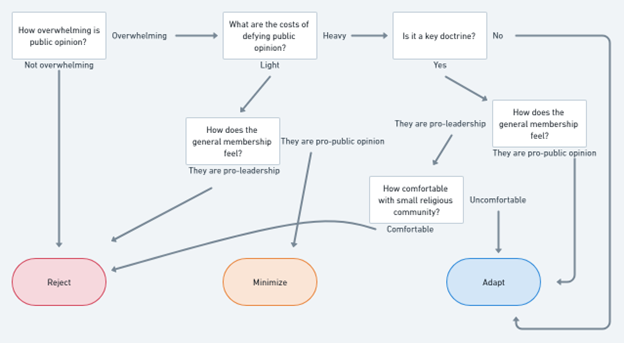Church Leadership Decision Factors: Part Deux
I have been trying to develop a model to explain how church leaders react to changing public opinion regarding some issue. I had initially developed this preliminary flowchart:

But I wanted to formalize it, despite that not being in my wheelhouse at all. So I started off by making a list of every reasonably likely factor I could think of that might influence how church leaders make decisions in the face of public opinion. And then, tried to combine and reduce those factors into a small range of operational ones that can be plotted. That’s where I am right now, and it is a messy place. Less messy than it was, but still rather intimidating. I hope to arrive at a place where the logic of the flowchart can be derived from a two dimensional model. But that’s a long way away, as you’ll be able to tell. This is what I’ve got so far:

The dots (smudges really, I just peppered the graph with my stylus) represent hypothetical individuals that churches are seeking to recruit or retain.
The X-axis is the range of opinions people have on some issue.
The Y-axis, which I like to call the “Heresy Allowance” shows how much one can deviate from established church policy without being punished. It also indicates how severe the punishment is, the likelihood of detection, and the likelihood and level of enforcement (including what enforcement mechanisms exist, formal and informal (i.e. excommunication, withholding of communion, belief in hell, shunning from other members, lack of callings extended)).
The Y-axis can also be interpreted through the church’s viewpoint or an individual. That is, churches differ in the level of deviance they allow from established practices. But individuals also differ in the level of orthodoxy-enforcement desire. Some individuals want to be part of a church that strictly enforces beliefs and behaviours, while others prefer a looser approach. In other words, a zealots and moderates seeks like-minded practitioners.
Within this model, behaviour is driven by three principles. Well, really one principle and two sub-principles. That is, church leaders are motivated to (1) sustainably gain as many members as possible without (2) compromising the brand or identity of the church or (3) violating what they actually believe (or want to believe) the doctrine to be.
So, using the model visualization, churches want to situate themselves amid the greatest concentration of dots without compromising points a & b.
More coming soon!